
Table of Contents
What is color psychology?
Color psychology is a multidisciplinary field that examines how colors affect human emotions, behaviors, and cognitive processes.
It explores the psychological and physiological responses triggered by different hues, shades, and combinations.
Scientific research in color psychology aims to uncover the underlying mechanisms that link colors to emotions, behaviors, and cognitive processes.
Studies have shown that different colors can evoke specific emotional responses, such as red increasing arousal and attention, or blue inducing a sense of relaxation and calmness.
Additionally, colors can impact cognitive processes, with some hues promoting creativity and others enhancing focus and attention.
The Importance of Color in interior design.

When it comes to interior design, color is a powerful tool that can transform spaces, evoke emotions, and influence our moods.
The study of color psychology delves into the impact of different hues on human behavior and mental well-being.
By understanding the intricacies of color psychology, interior designers can create spaces that look visually appealing and enhance the overall experience of the occupants.
Let’s delve into the fascinating world of color psychology in interior design and explore how different colors can shape our perception of a space.
Choosing the right colors for your space.
Red

The color red is vibrant, energetic, and attention-grabbing, making it a bold choice for interior design.
However, due to its stimulating nature, it is essential to use red strategically and consider the specific rooms where it would be most suitable.
Here are a few rooms where the color red can be effectively incorporated:
Living Room
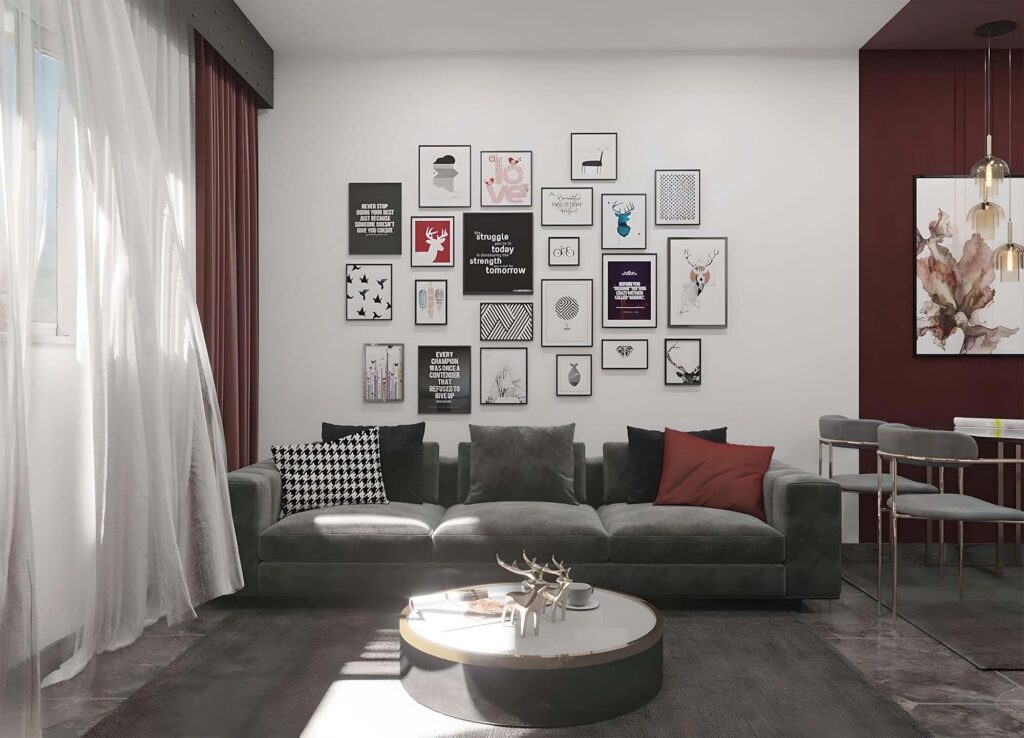
The living room is a social space where people gather and engage in conversation.

Red can create a warm and inviting atmosphere, encouraging lively discussions and a sense of togetherness.

It can be used on an accent wall, through red furniture pieces like a statement sofa or armchair, or through accessories like throw pillows or curtains.
Dining Room

Red is known to stimulate appetite and increase energy levels, making it an ideal choice for the dining room.
It can create a lively and stimulating environment, perfect for enjoying meals with friends and family.
Red can be incorporated through red dining chairs, a red tablecloth, or even red artwork on the walls.
Home Office
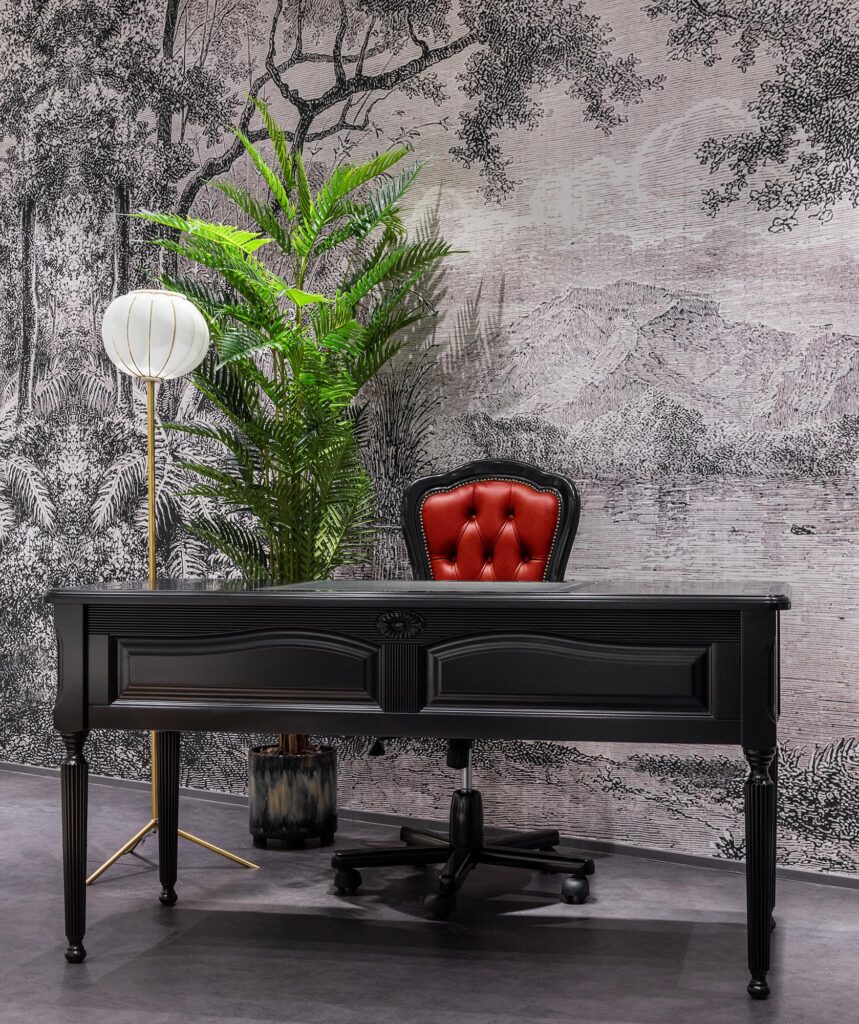
Red can be an excellent choice for a home office, as it promotes productivity, focus, and determination.
However, it is crucial to use red in moderation to avoid overwhelming the space.
Consider using red accents like a red desk chair or desk lamp or through red storage organizers.
Exercise Room or gym

Red is a highly energizing color that can add motivation and intensity to an exercise room.
It can increase heart rate and energize the body, perfect for workouts.
Incorporate red through red exercise equipment, red motivational quotes on the walls, or red flooring to create a refreshing space.
Children’s room
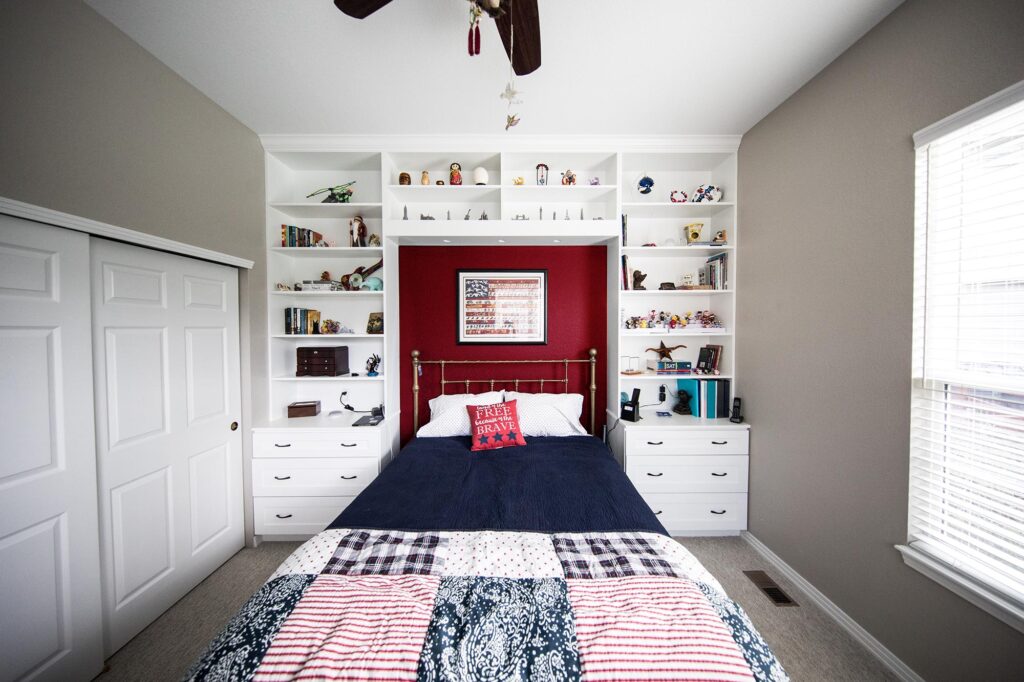
Red is a lively and stimulating color that can inspire creativity and imagination.
In a playroom, red can foster energy and enthusiasm.
It can be incorporated through red play mats, red toy storage bins, or even red-themed wallpaper.
Remember, when using red in any room, it is crucial to balance it with other colors to create a harmonious and visually appealing space.
Use complementary colors like neutrals, such as white or gray, to temper the intensity of red and provide visual balance.
Blue

The color blue is known for its calming and serene qualities, making it an excellent choice for creating tranquil and soothing spaces within a home.
Here are some specific rooms where the color blue can be effectively incorporated:
Bedroom

The bedroom is a sanctuary for relaxation and sleep, making blue an ideal color choice.
Shades of blue, such as soft pastels or muted blues, can create a serene and peaceful atmosphere, promoting restful sleep.
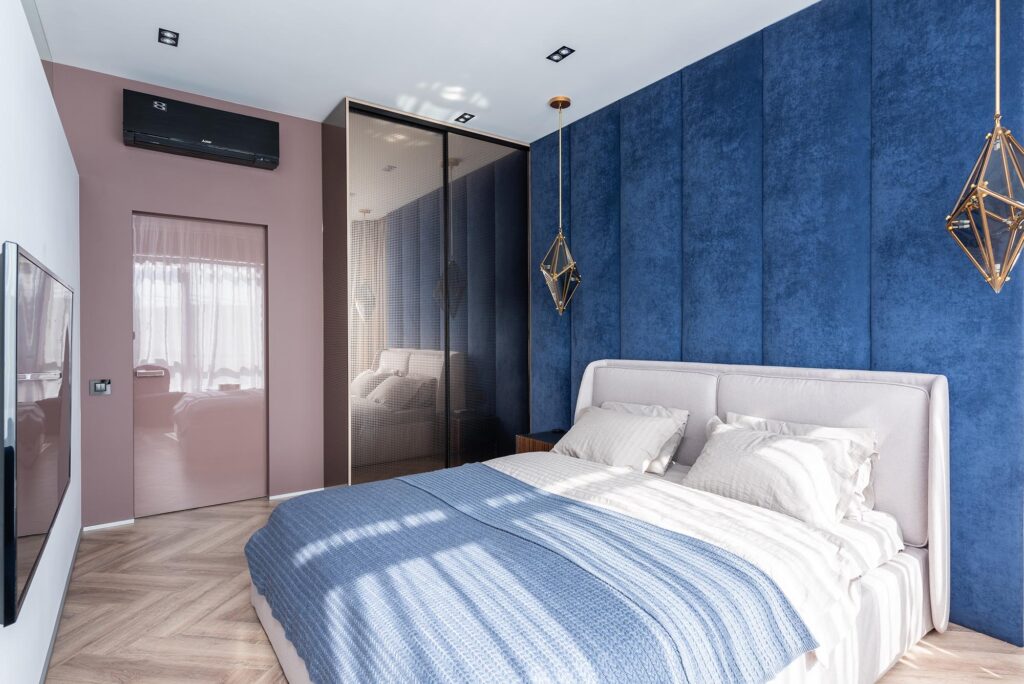
Consider using blue for walls, bedding, curtains, or even as accents through artwork or decorative accessories.
Bathroom

Blue is often associated with water and cleanliness, making it a popular choice for bathrooms.
Lighter shades of blue can evoke a spa-like ambiance, creating a sense of tranquility and freshness.

Blue tiles, a blue shower curtain, or blue towels can all contribute to a calming and refreshing bathroom environment.
Home Office or Study

In a home office or study space, blue can promote focus, concentration, and productivity.
It helps create a calm and organized atmosphere, allowing for better cognitive functioning.
Consider using blue for the walls, a blue desk or chair, or even blue storage solutions to enhance the work environment.
Living Room

While blue is known for its calming effects, it can also create a sense of coolness and freshness.
In the living room, blue can be used to evoke a peaceful and inviting atmosphere.
Lighter shades of blue can make the room feel more spacious, while darker blues can add a sense of depth and coziness.
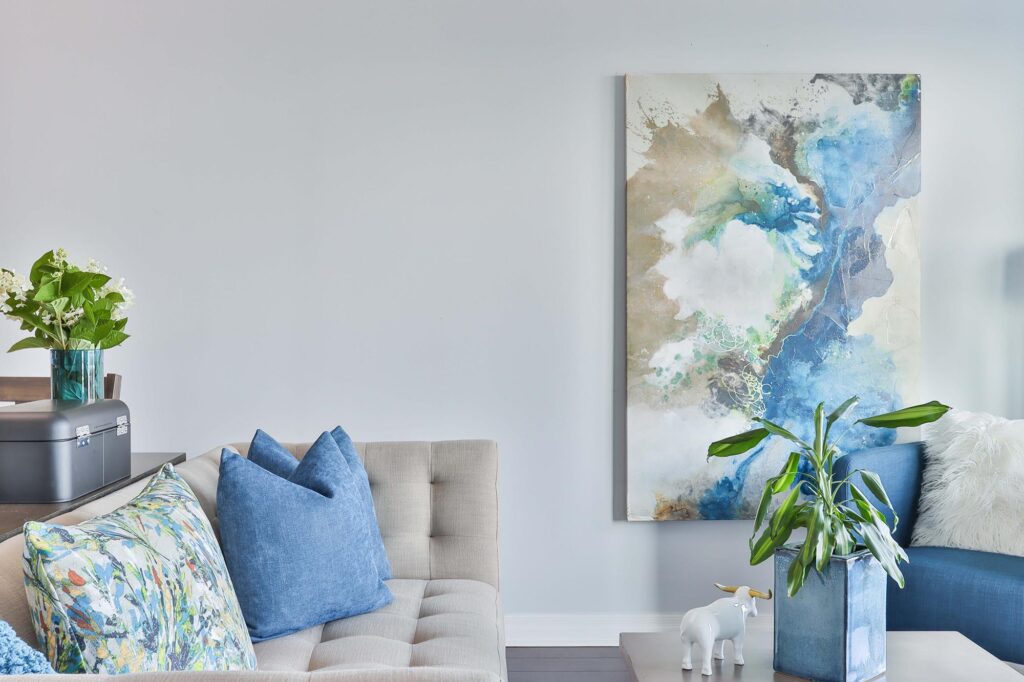
Incorporate blue through furniture upholstery, blue accent pillows, or blue artwork.
Nursery or Children’s Room

Blue is a popular choice for nurseries and children’s rooms due to its association with calmness and security.
Light blue hues can create a soothing environment for babies, while brighter blues can be stimulating for young children.
Consider using blue wallpaper, blue bedding, or blue rugs to create a peaceful and comforting space.
Coastal-Themed Rooms

Blue is often associated with the ocean and beach, making it a perfect choice for coastal-themed rooms.
Whether it’s a beach-inspired living room, a coastal bedroom, or a seaside-themed bathroom, blue can help create a relaxing and refreshing coastal atmosphere.
Use various shades of blue, along with natural materials and textures, to complete the coastal look.
When incorporating blue into any room, consider the specific shade and intensity of blue that aligns with the desired mood and ambiance.
Additionally, pairing blue with complementary colors, such as neutrals like white or beige, or contrasting colors like coral or yellow, can enhance the overall aesthetic and create a harmonious space.
Yellow
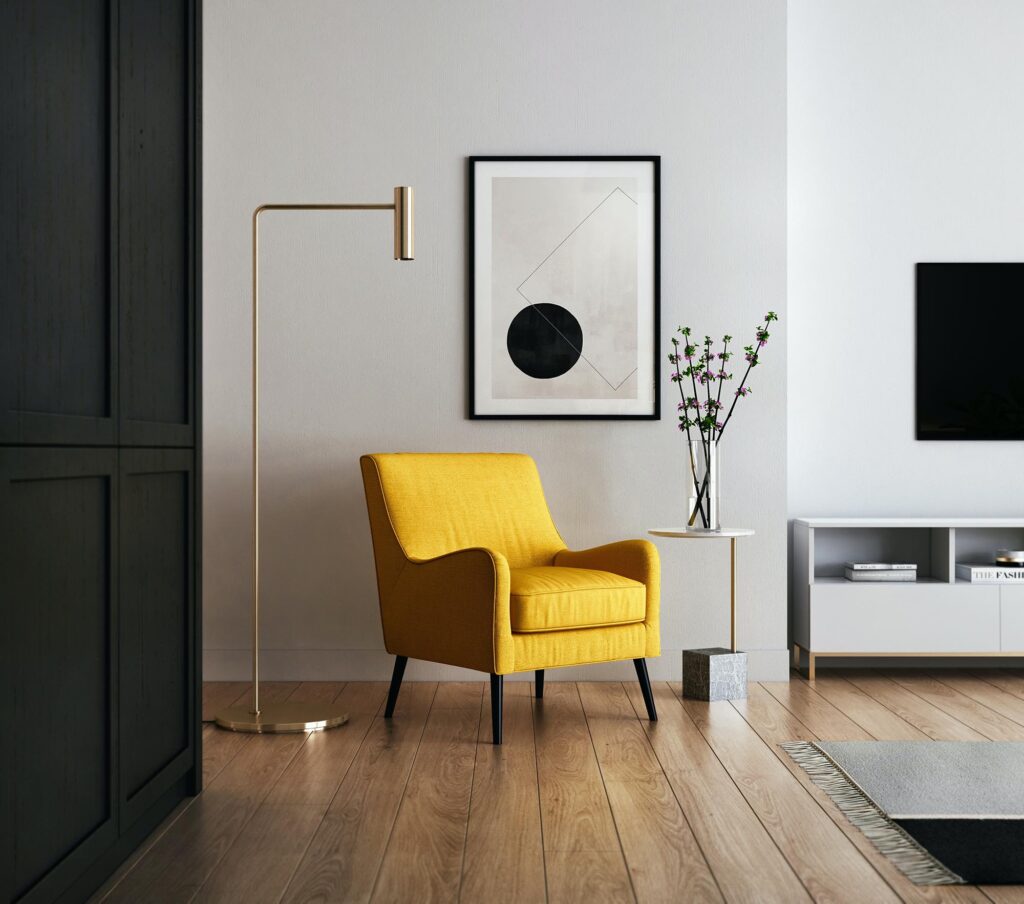
The color yellow is vibrant, cheerful, and associated with happiness and positivity, making it an excellent choice for creating lively and uplifting spaces within a home.
Here are some specific rooms where the color yellow can be effectively incorporated:
Kitchen

Yellow is often associated with energy and warmth, making it a perfect choice for the heart of the home – the kitchen. Use yellow for kitchen cabinets, backsplash tiles, or accent walls to create a bright and inviting atmosphere.
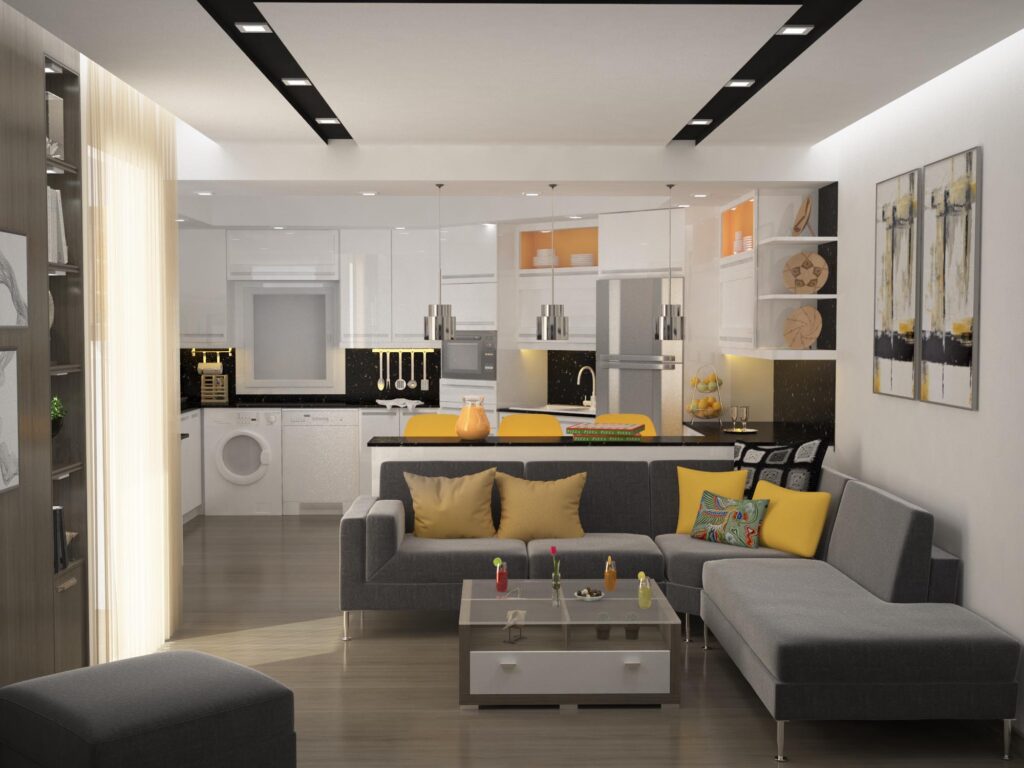
Yellow kitchen accessories, such as utensils, dishware, or small appliances, can also add pops of cheerful color.
Living area
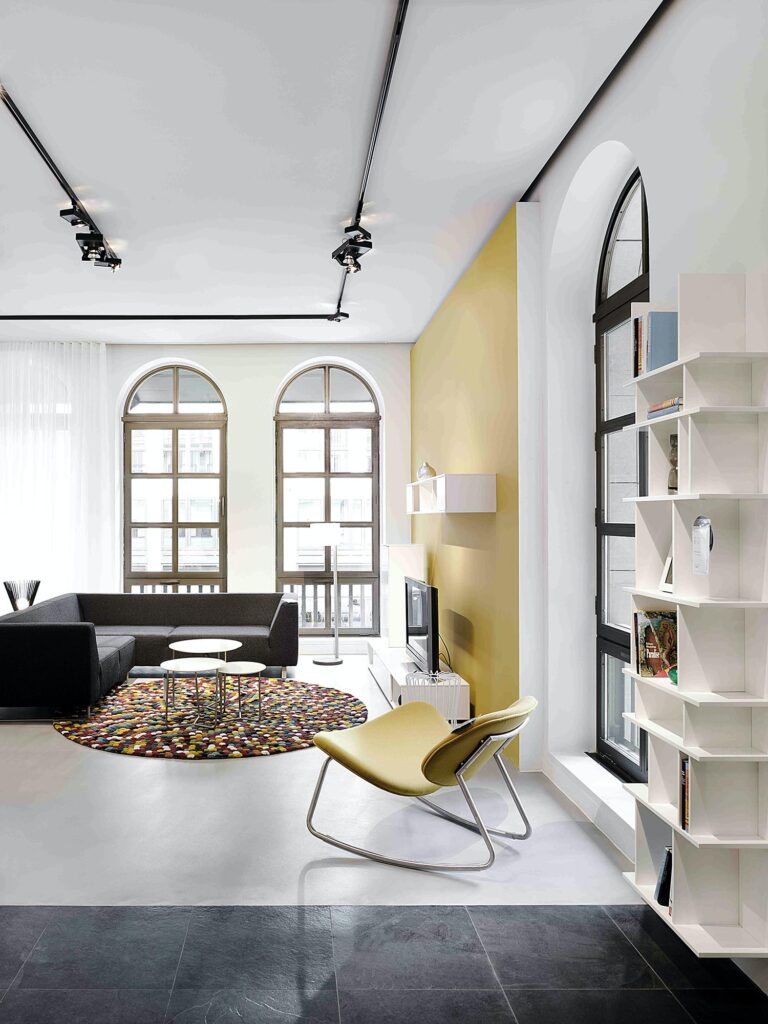
A living area is an ideal space to infuse the warmth and vibrancy of yellow.
Yellow upholstery on chairs or a yellow wall can instantly uplift the mood and create a joyful experience.

Pair yellow with neutral colors like white or light wood to balance the vibrancy and create a visually pleasing environment.
Home Office

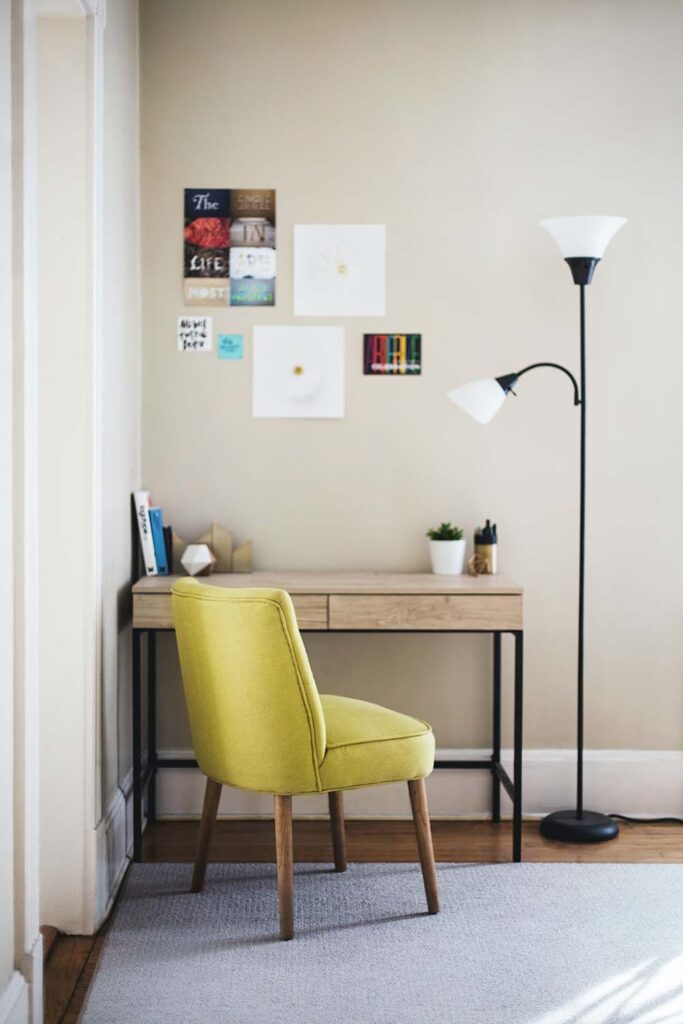
Yellow can stimulate creativity, focus, and optimism, making it an excellent color choice for a home office or creative workspace.
Paint an accent wall in a soft yellow shade or incorporate yellow through furniture, such as a yellow desk or chair.
Yellow decor items like desk accessories, artwork, or inspirational quotes can also add a touch of energy to the space.
Children’s Playroom

Yellow is a joyful and playful color, making it an ideal choice for a children’s playroom.
Use yellow as a primary color for walls, furniture, or flooring to create a vibrant and stimulating environment.
Incorporate yellow through playful patterns, rugs, storage bins, or wall decals to add an extra dose of cheerfulness to the space.
Entryway or Foyer

The entryway sets the tone for the rest of the home, and yellow can create an inviting and welcoming atmosphere for guests.
Consider painting the front door in a bold yellow hue or incorporating yellow accents through artwork, mirrors, or decorative accessories.
Yellow can instantly uplift the mood and make a positive first impression.
Home Gym
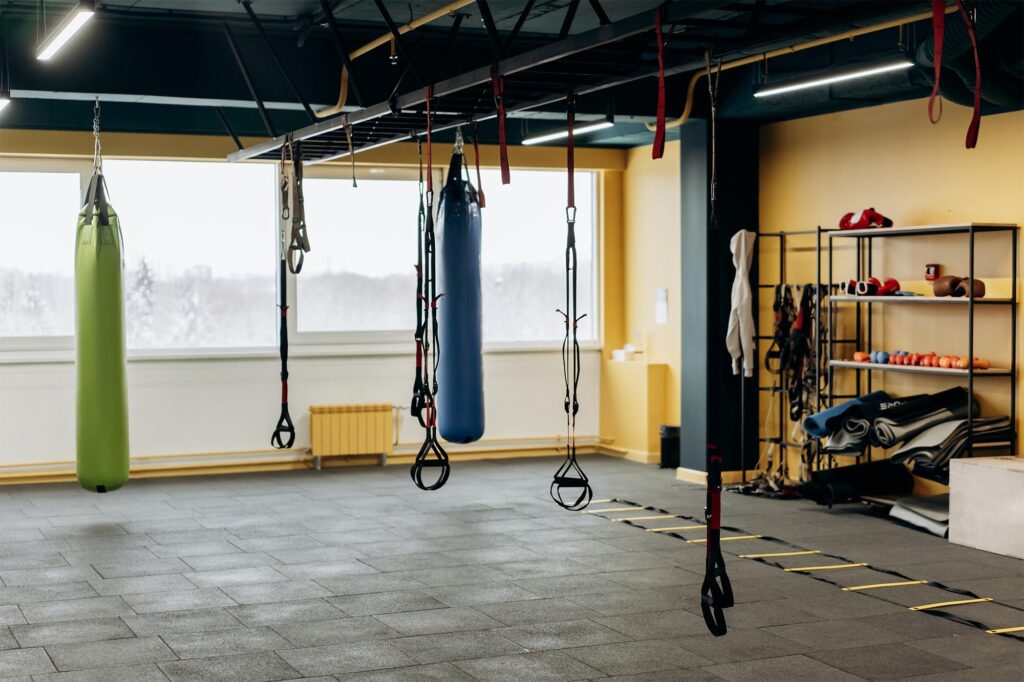
yellow is known to evoke energy and enthusiasm, making it an ideal choice for a home gym or exercise space.
It can help motivate and invigorate workouts.
Consider using yellow for gym equipment, exercise mats, or wall paint.
Yellow motivational quotes or artwork can also add a motivational element to the space.
When using yellow, it’s essential to strike a balance and consider the intensity of the shade.
Soft and muted yellows can create a calming effect, while brighter and bolder yellows can add vibrancy and energy.
Additionally, combining yellow with complementary colors like white, gray, or even blue can create a harmonious and visually appealing space.
Green

The color green is associated with nature, balance, and tranquility, making it an excellent choice for creating refreshing and harmonious spaces within a home.
Here are some specific rooms where the color green can be effectively incorporated:
Bedroom

Green is a calming and soothing color, making it an ideal choice for the bedroom.
It promotes a sense of relaxation and tranquility, helping to create a peaceful atmosphere for sleep.

Consider using green for walls, bedding, curtains, or even indoor plants to bring the calming effects of nature into the space.
Bathroom

Green is often associated with freshness and renewal, making it a perfect color for bathrooms.
Lighter shades of green can create a spa-like ambiance, evoking a sense of serenity and cleanliness.
Use green tiles, and a green shower curtain, or incorporate green accessories like towels or bath mats to enhance the refreshing atmosphere.

Living Room
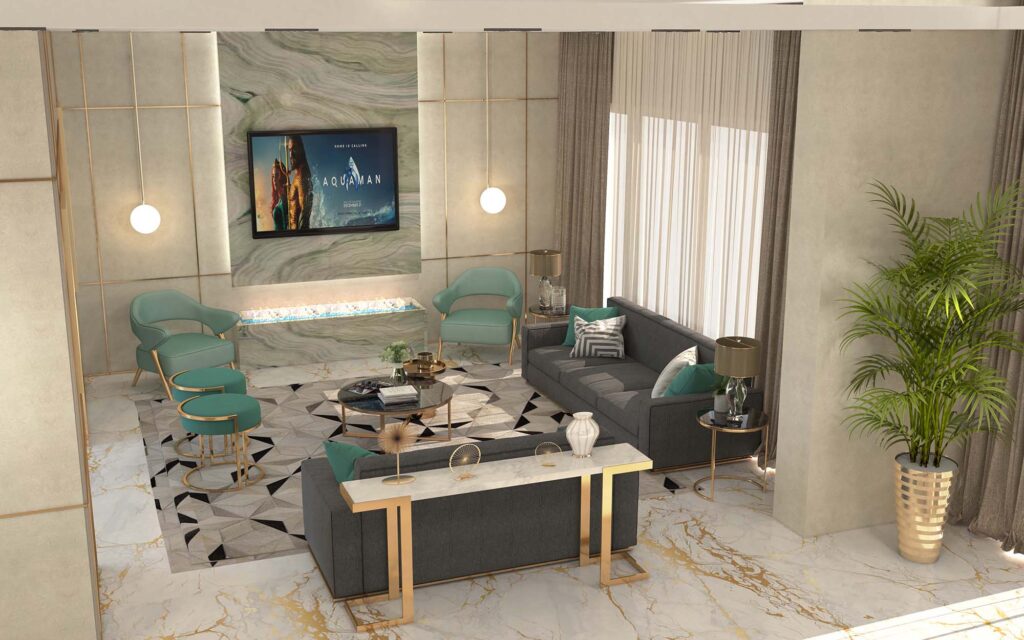
Green can create a sense of balance and harmony in the living room, making it a popular choice for this space.
From soft and muted greens to deeper shades, green can add a touch of nature and bring the outdoors inside.
Use green for accent walls, furniture upholstery, throw pillows, or even potted plants to create a calming and inviting environment.
Home Office or study area

Green is believed to enhance concentration and focus, making it an excellent color choice for a study or home office.
It can create a sense of mental clarity and productivity.
Consider using green for the walls or as an accent color through a green desk chair, green storage solutions, or green artwork to promote a balanced and efficient work environment.
Kitchen

Green can add a fresh and invigorating element to the kitchen, especially when combined with white or light wood tones.
Green can be incorporated through green cabinets, a green backsplash, or even green kitchen accessories like utensils or small appliances.
It can create a lively and refreshing space for cooking and gathering.
Conservatory or Sunroom

A conservatory or sunroom is an ideal space to bring the color green to life, as it connects with the surrounding outdoor environment.
Floor-to-ceiling windows allow plenty of natural light, creating an ideal setting for indoor plants and lush greenery.
Furnish the space with green furniture, cushions, or curtains to enhance the connection with nature and create a tranquil retreat.
When using green, consider the shade and intensity that aligns with the desired mood and ambiance.
Soft and muted greens can create a more calming effect, while brighter greens can add vibrancy and freshness
Pair green with complementary colors like white, cream, or earth tones to create a harmonious and visually pleasing space that connects with nature.
Purple

The color purple is often associated with luxury, creativity, and spirituality, making it a bold and intriguing choice for interior design.
Here are some specific rooms where the color purple can be effectively incorporated:
Bedroom

Purple is a rich and opulent color that can create a sense of luxury and relaxation in the bedroom.
Soft lavender or lilac shades can evoke a serene and calming atmosphere, perfect for promoting restful sleep.
Deep purple hues can add a touch of drama and create a cozy and romantic ambiance.
Use purple for bedding, curtains, accent walls, or through decorative elements like pillows or rugs.
Meditation or Yoga Room

Purple has a strong association with spirituality and introspection, making it an excellent choice for a meditation or yoga room.
It can help create a serene and focused environment, conducive to mindfulness practices.
Consider using shades of purple on the walls, floor cushions, meditation mats, or even through purple-scented candles to enhance the meditative experience.
Living Room:

Purple can add a sense of sophistication and elegance to the living room.
Use shades of purple for upholstery on sofas, armchairs, or ottomans to create a luxurious and visually captivating space.
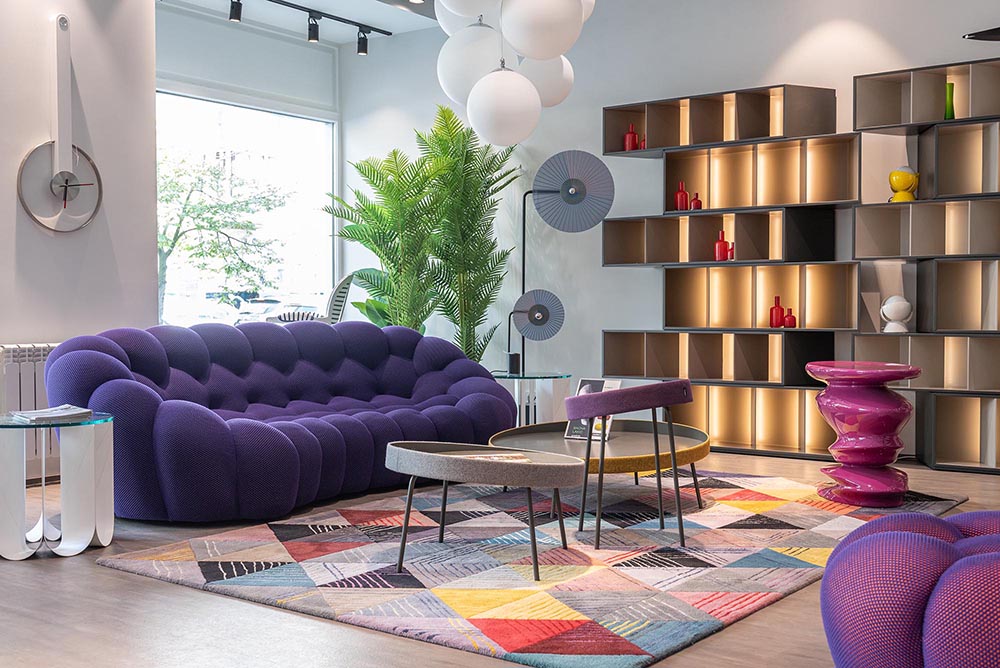
Deep purples can be balanced with lighter colors and neutral tones to create a harmonious and inviting atmosphere.
Introduce purple through curtains, decorative pillows, or artwork to add pops of color and create focal points.
Dining Room:

Purple can create an intimate and lavish atmosphere in the dining room.
Use deep purple or plum shades for dining chairs or upholstered dining benches to add a touch of regal elegance.
Purple table linens, such as tablecloths or napkins, can enhance the dining experience and create a sense of luxury.
Combine purple with metallic accents like gold or silver for a glamorous dining space.
When using purple, it’s important to consider the specific shade and intensity that aligns with the desired mood and ambiance.
Lighter shades of purple can create a softer and more ethereal atmosphere, while deeper purples can add richness and depth.
Additionally, balancing purple with neutral colors and complementary hues can create a well-rounded and visually appealing space.
Orange

For those seeking energy and optimism, orange is the color of choice.
The color orange is vibrant, energetic, and associated with warmth and creativity.
It can add a bold and lively touch to interior spaces.
Here are some specific rooms where the color orange can be effectively incorporated:
Living Room:
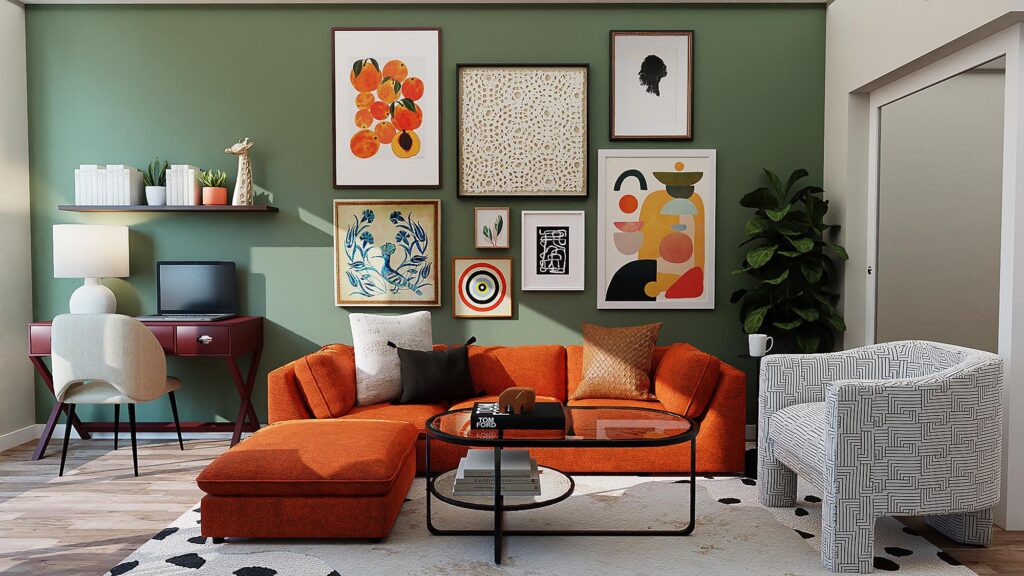
Orange can create a vibrant and inviting atmosphere in the living room.
It stimulates conversation and social interaction.
Use orange as an accent color through throw pillows, curtains, or an area rug.
Consider incorporating orange through furniture pieces like an orange sofa or armchair to create a focal point and add a playful element to the space.
Kitchen:
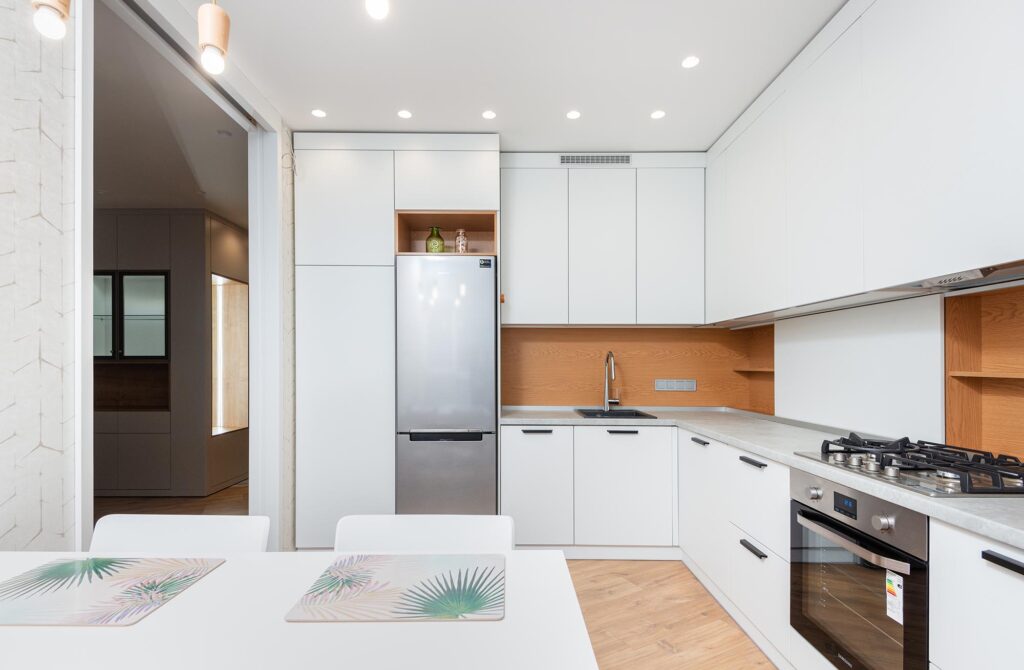
Orange is a stimulating color that can energize the kitchen space.
Use orange for kitchen cabinets, backsplash tiles, or countertops to add a pop of color and create a lively and cheerful cooking area.
Orange kitchen appliances or small accessories like orange cookware or utensils can also enhance the overall vibrancy of the kitchen.
Children’s Playroom:

Orange is a playful and fun color, making it an excellent choice for a children’s playroom.
It can stimulate creativity and imagination.
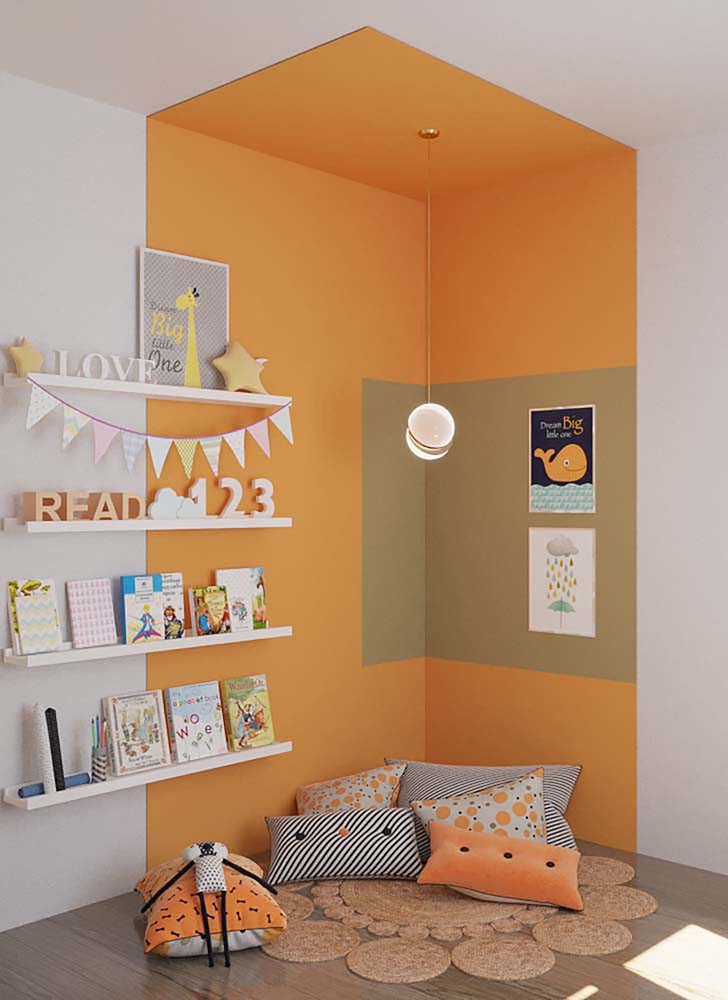
Use orange for walls, furniture, or as accent colors through storage bins or shelving.
Combine orange with other bright and lively colors to create a vibrant and joyful play space.
Sunroom or balcony:

Orange can enhance the warm and sunny atmosphere of a sunroom or balcony.
It can complement the natural light and create an inviting and cozy space.
Use orange for upholstery on furniture, cushions, or even window treatments.
Combine orange with natural materials like wicker or rattan to create a harmonious and nature-inspired environment.
When using orange, it’s important to strike a balance and consider the intensity of the shade.
Bright and bold oranges can create a lively and energetic atmosphere, while softer shades can evoke a more relaxed and warm ambiance.
Additionally, pairing orange with complementary colors like blue or gray can create a visually appealing and balanced space.
Black

The color black is bold, sophisticated, and timeless.
While it may seem unconventional for interior design, when used thoughtfully, black can create dramatic and elegant spaces.
Here are some specific rooms where the color black can be effectively incorporated:
Bedroom:

Black can add a touch of luxury and create a cozy and intimate atmosphere in the bedroom.
Consider using black for statement pieces like a bedframe, headboard, or dresser.

Pair black with softer colors like white or gray for a balanced and elegant look. Incorporate black through bedding, curtains, or decorative elements like lamps or artwork to add depth and contrast.
Home Office:

Black can bring a sense of focus and sophistication to a home office.
It can create a sleek and professional atmosphere.
Consider using black for a desk or shelving unit.

Pair black with lighter colors like white or cream for a clean and modern aesthetic. Use black for office accessories like desk organizers, storage boxes, or even a blackboard wall for a stylish and functional workspace.
Dining Room and Kitchen:

Black can create a dramatic and sophisticated ambiance in the dining room.
Use black for the dining table or chairs to make a bold statement.

Pair black furniture with lighter elements like a white or cream-colored tablecloth, or incorporate metallic accents like silver or gold for added elegance.
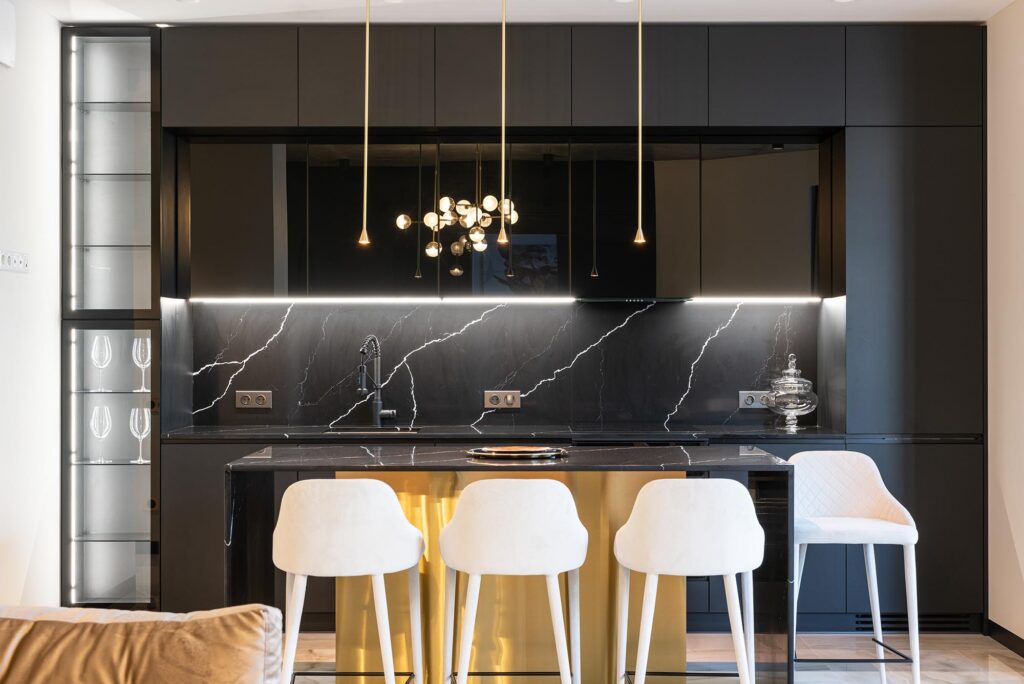
Black chandeliers, pendant lights, or wall sconces can further enhance the dramatic effect.
Bathroom:
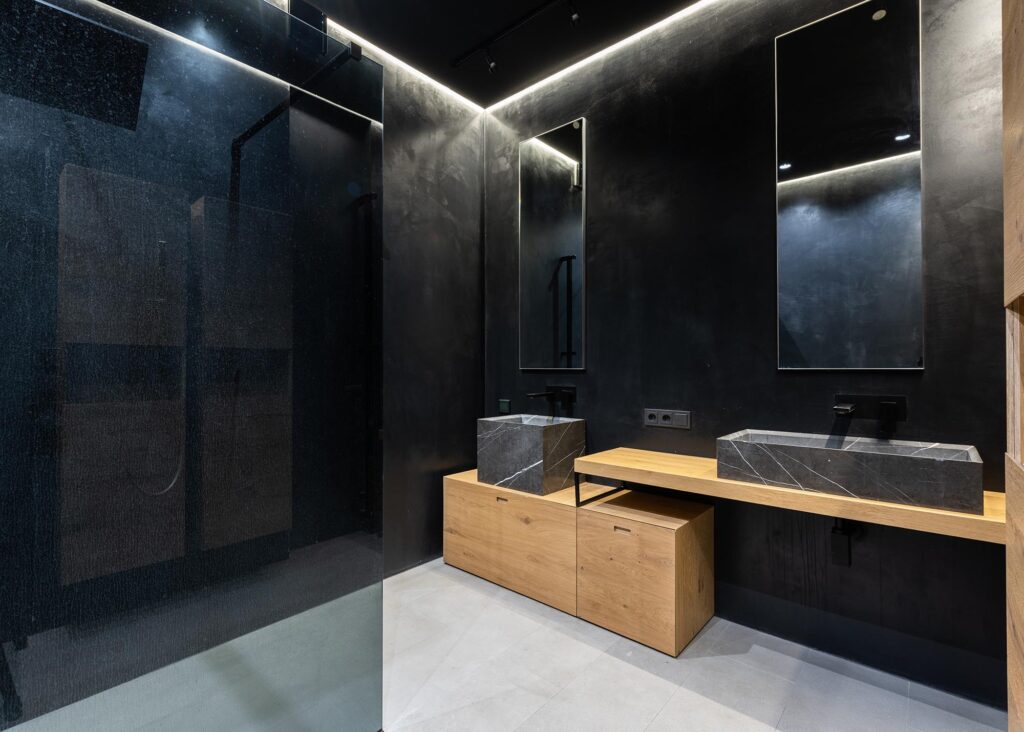
Black can bring a sense of luxury and indulgence to the bathroom.
Consider using black tiles for the floor or shower walls to create a striking visual impact. Pair black with white fixtures like a bathtub or sink for a classic and timeless look.
Incorporate black towels, rugs, or accessories like soap dispensers or toothbrush holders for added sophistication.
Entryway or Foyer:

Black can create a striking and memorable first impression in the entryway or foyer.
Use black for the front door, accent wall, or staircase railing to make a bold statement.

Pair black with light-colored floorings, such as white tiles or light wood, for contrast.
Incorporate black through a console table, mirror frame, or lighting fixtures for a sophisticated and welcoming entry space.
When incorporating black, it’s important to consider lighting and balance.
Black absorbs light, so ensure proper lighting to prevent the space from feeling too dark or cramped.
Balance the black with lighter or contrasting elements to create depth and visual interest.
Additionally, consider incorporating texture and patterns to add dimension and prevent the space from feeling flat.
Neutral colors

Neutral colors like white, grey, and beige are versatile and timeless, creating a sense of tranquility, sophistication, and flexibility within a home.
Here are some specific rooms where these neutral colors can be effectively incorporated:
Living Room:

Neutral colors are well-suited for the living room, as they provide a calm and neutral backdrop for various decor styles.
Use shades of white, grey, or beige for walls, allowing the flexibility to incorporate different furniture and accent colors.

Neutral-colored sofas, armchairs, and coffee tables can create a timeless and elegant living room design.

Adding pops of color through throw pillows, artwork, or decorative accessories can add visual interest.
Kitchen:
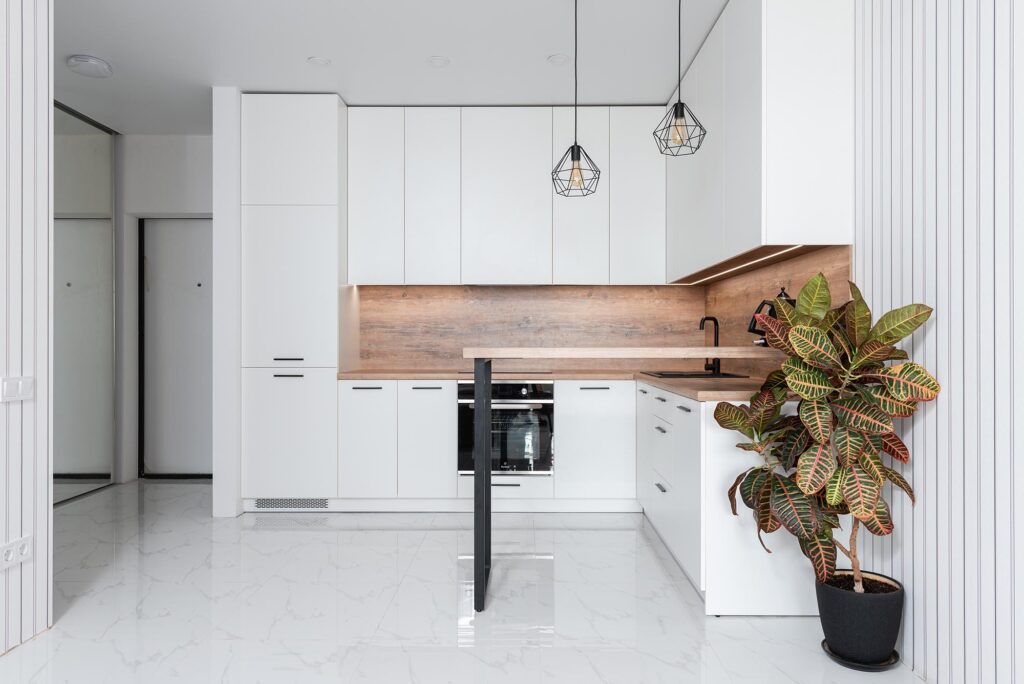
Neutral colors are a popular choice for kitchens, as they create a clean and modern look. White or light grey cabinets and countertops can provide a fresh and airy feel.

Beige or off-white tiles or backsplash can complement the overall design.
Accents of stainless steel appliances or metallic fixtures can add a touch of sophistication.
Bedroom:

Neutral colors in the bedroom create a serene and relaxing atmosphere, promoting restful sleep.
White, light grey or beige walls can serve as a calming backdrop.
Use neutral bedding, such as white or light grey sheets and duvet covers, to create a tranquil sleeping environment.

Introduce warmth through wooden furniture or textured fabrics like a beige upholstered headboard or grey knitted throw pillows.
Bathroom:
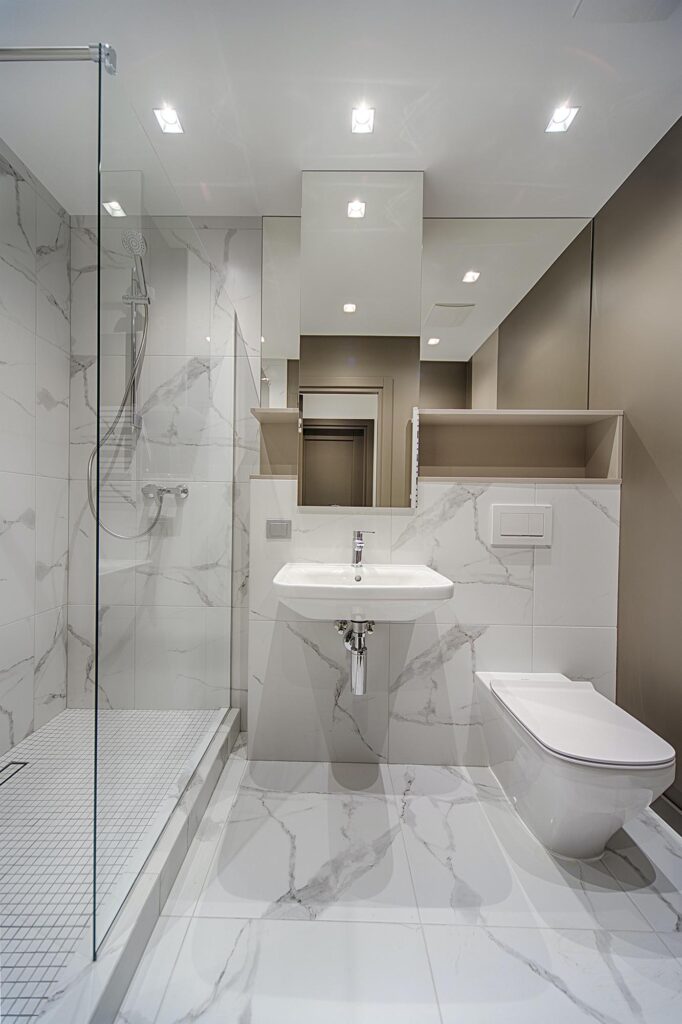
Neutral colors work well in bathrooms, providing a clean and spa-like feel.
White tiles for the walls or floor can create a bright and fresh ambiance.
Grey or beige accents, such as towels or bath mats, can add warmth and texture.

Consider using a mix of neutral-colored natural materials like stone or wood to create a harmonious and soothing bathroom design.
Home Office:

Neutral colors in a home office can promote focus and productivity.
Light grey or beige walls can create a calm and balanced environment.
White or light-colored desks, bookshelves, and cabinets can enhance the overall functionality of the space.
Incorporate pops of color through office supplies, artwork, or plants to add visual interest and inspiration.
Incorporating neutral colors allows for versatility and flexibility in terms of furniture and decor choices.
They serve as a blank canvas for personal style preferences, allowing you to easily change and update the look of the space over time.
When using neutral colors, consider adding texture, varying shades, and pops of color through accessories to create depth and visual interest within the room.
Final thoughts on color psychology in interior design
However, it is important to note that color effects are highly subjective and can vary among individuals.
Personal preferences, cultural backgrounds, and contextual factors all contribute to the interpretation and experience of color.
Therefore, while color psychology provides valuable insights into the potential impact of colors on human psychology, its application in design should consider the unique characteristics and needs of the individuals and the context in which they are presented.
